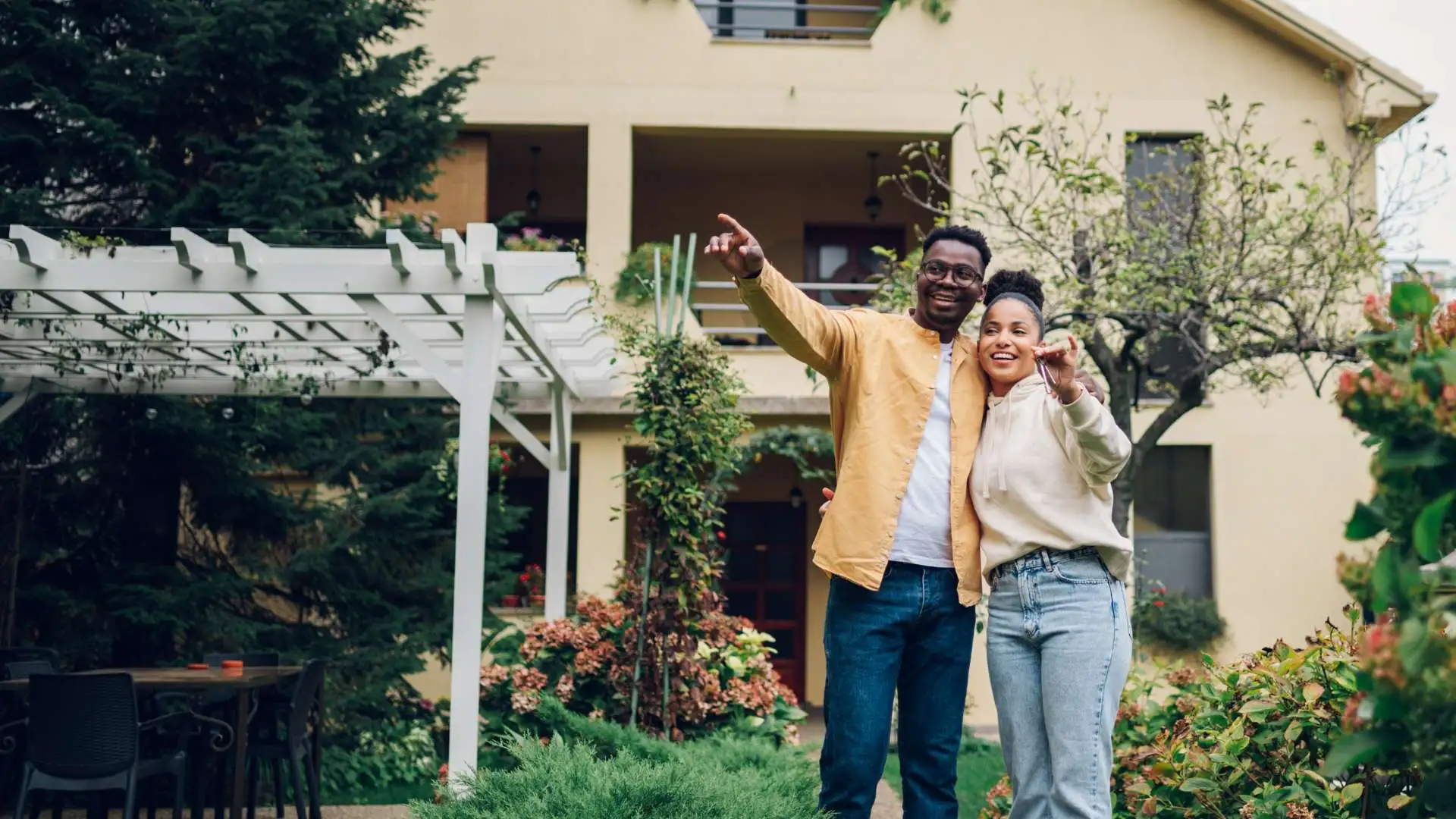Table of Contents
The Fork in the Road for American Families
For decades, the path seemed clear: buy a starter home as soon as possible, build equity, and upgrade when ready. But in 2025, that advice is being questioned like never before.
Mortgage rates are around 6.5%, home prices remain historically high, and starter homes, once affordable stepping stones, are now rare and often far from perfect. Renting, meanwhile, has cooled slightly since its pandemic-era surge, making it a tempting option for families who feel priced out of ownership.
So here’s the real question: in today’s economy, is it smarter to buy a starter home now, or rent and wait until conditions improve? The answer is far from simple. It’s financial, emotional, and deeply personal. Let’s unpack it.
What Exactly Is a Starter Home?
Traditionally, a starter home was a modest, affordable property that first-time buyers could manage while planning to upgrade later. Think two bedrooms, one bathroom, a small yard; functional, but not forever.
In 2025, however, starter homes have become harder to define. With inventory tight and investors buying up affordable properties, today’s “starter” often costs $250,000–$400,000, depending on the region. Many need significant repairs, lack space for growing families, or are in less convenient areas.
For some buyers, the modern starter home feels more like a compromise than a stepping stone. For others, it’s the only way into the market before prices climb.
Read related blog: Read related blog: Financial Checklist for Buying Your First Home
The Case for Buying a Starter Home Now
Buying a starter home today offers financial advantages and psychological stability that renting cannot replicate.
1. Building Equity Early
Every mortgage payment you make reduces your loan balance and increases your ownership stake. Even in a high-rate environment, equity adds up over time. A $300,000 home appreciating at just 3% annually could grow to $360,000 in five years, adding $60,000 in value before considering loan paydown.
Rent, on the other hand, does not build equity. Over the same five years, renters could spend $125,000–$150,000 with nothing tangible to show.
2. A Hedge Against Rising Prices
If you buy today, you lock in your price. Even if rates drop later, home prices may climb again, canceling the benefit. Many buyers who “waited for prices to fall” in the early 2010s paid more as values surged during the recovery.
3. Stability and Control
Owning means no landlord surprises, no yearly rent hikes, and no forced moves. For families with children, stability in schools and neighborhoods can outweigh the imperfections of a starter home.
4. The Option to Rent Out Later
Starter homes can often become rental properties when you upgrade. This turns the “stepping stone” into a long-term investment, generating income even after you move on.
Read related blog: Understanding Waiting Periods In Job Loss Insurance Protection: A Step-By-Step Guide
The Case for Renting and Waiting
Despite the pull of ownership, renting in 2025 has real strengths, especially in a high-rate market.
1. Lower Monthly Costs
In many metros, renting is still cheaper than buying — sometimes by $500–$1,000 monthly once taxes, insurance, and maintenance are included. For families living paycheck to paycheck, that difference is crucial.
2. Flexibility in a Changing Job Market
Remote work, layoffs, and industry shifts mean committing to one location can be risky. Renting keeps you mobile. If you need to relocate for work or family, breaking a lease is far easier (and cheaper) than selling a house.
3. More Time to Save
Renting allows you to build a stronger down payment, which lowers future borrowing costs. Saving an extra $20,000 over a few years could mean the difference between stretching for a starter home and comfortably affording a long-term property.
4. Avoiding Hidden Homeownership Costs
Renters don’t pay for roofs, furnaces, or plumbing disasters. Owners do — often at the worst possible time. Renting shields families from these budget-shaking surprises while they build financial stability.
The Psychology of ‘FOMO’ in Housing Decisions
One of the strongest forces shaping starter home decisions in 2025 isn’t financial; it’s emotional. Many buyers fear missing out (FOMO) when they see friends, coworkers, or family members buying homes. This pressure can push people into rushing decisions, even if they’re not financially ready.
The problem is that FOMO doesn’t pay the mortgage. Buying too soon can lead to “house poor” stress, resentment, or even foreclosure if life circumstances change. On the flip side, the fear of missing out can paralyze renters, making them feel like every year spent renting is wasted.
Understanding these psychological pressures helps families make clearer decisions. A home should be a foundation for stability, not a rushed purchase because of social comparison.
Read related blog: Still Waiting for Your Tax Refunds? Millions Delayed by IRS Backlog
The Financial Math: A Head-to-Head Comparison
Let’s compare renting vs buying a starter home in a real-world scenario:
Scenario: $300,000 starter home vs $2,000/month rent
- Buying (10% down, 6.5% mortgage):
- Mortgage + taxes + insurance: ~$2,200–$2,400/month
- Maintenance: ~$3,000 annually
- Upfront costs: ~$40,000 (down payment + closing)
- Mortgage + taxes + insurance: ~$2,200–$2,400/month
- Renting:
- $2,000/month rent
- No maintenance or property taxes
- Upfront costs: ~$4,000 (deposit + first month)
- $2,000/month rent
Outcome after 5 years:
- Buyer builds ~$50,000–$70,000 in equity (loan paydown + appreciation).
- Renter saves $200–$400/month, or ~$12,000–$24,000 total — assuming they actually invest the difference.
The deciding factor? Discipline. Buyers build equity automatically. Renters must intentionally save and invest to come out ahead.
The Risk of Buying Too Soon
There’s a danger in rushing into ownership to “get in the game.”
- High Rates Mean High Payments: Stretching your budget for a starter home can leave you “house poor,” unable to save for emergencies or enjoy life.
- Costly Upgrades: Many starter homes need repairs or renovations, draining cash reserves.
- Selling Too Quickly: If you move before 5–7 years, transaction costs (6% realtor fees + moving) can wipe out any equity gains.
Buying too soon for families uncertain about their job stability, location, or long-term goals can backfire.
The Emotional Side: Pride vs Flexibility
Numbers tell only half the story. Housing is deeply emotional.
- Owners feel pride, control, and permanence. Even a modest starter home is “theirs.”
- Renters enjoy freedom and less stress about maintenance or repairs, but often feel “falling behind.”
This emotional tension is real. For many, the value of peace of mind matters as much as the financial equation.
Generational Differences in Starter Home Decisions
- Gen Z & Young Millennials: More likely to rent and wait, prioritizing mobility and career changes.
- Older Millennials & Gen X: Lean toward buying starter homes for family stability and equity growth.
- Boomers: Many are selling larger homes, downsizing, or renting again for simplicity.
Generational wealth transfer also plays a role. Younger buyers without family help often can’t afford down payments, pushing them toward renting even if they’d prefer to buy.
Read related blog: How to Calculate Your Break-Even Point When Buying a House
How Interest Rates Change the Starter Home Equation
The conversation about renting versus buying is incomplete without acknowledging how much mortgage interest rates tip the scale. At 3% (like in 2020), a $300,000 starter home had a monthly payment around $1,250 (before taxes and insurance). At 6.5% (2025 levels), the same loan is nearly $2,000/month.
This difference is why many families who could afford a starter home five years ago are renting today. Rates not only affect monthly costs but also how quickly equity builds. Higher rates mean more of your payment goes to interest rather than principal.
For renters, this means patience could pay off; waiting for rates to drop could save tens of thousands over the life of a loan. For buyers, it means factoring in potential refinancing options down the line.
The Role of Location in Starter Home vs Renting
Where you live is just as important as whether you rent or buy. In some cities, starter homes barely exist anymore, and those that do are snapped up instantly by cash investors. In others, starter homes are plentiful and still affordable.
- High-cost metros (San Francisco, New York, Seattle): Renting often makes more sense here, as even starter homes cost more than $800,000, putting ownership out of reach for most families.
- Secondary cities (Cleveland, Indianapolis, St. Louis): Starter homes are still within reach, making buying a strong wealth-building option.
- Sunbelt & growth markets (Dallas, Phoenix, Tampa): Prices have climbed, but starter homes are more available, though rising demand may push renters further out.
Regional differences mean there’s no one-size-fits-all answer. A decision that looks wise in Chicago may look reckless in San Diego.
Read related blog: Top 10 Hidden Costs of Buying a Home Most Buyers Miss
Renting vs Buying and the Impact on Lifestyle Goals
The rent vs buy decision isn’t just about housing; it’s about lifestyle. Buying a starter home often has trade-offs: a smaller house, a longer commute, or fewer amenities. Renting, meanwhile, can give you access to neighborhoods you couldn’t afford to buy in.
For example:
- A renter might live in a city apartment near restaurants, cultural life, and short commutes.
- A starter home buyer may be further out, trading convenience for equity.
Families need to ask themselves: what matters more now — financial growth or lifestyle freedom? A starter home is an investment in tomorrow, but renting might give you a higher quality of life today. The right choice depends on what stage of life you’re in and what you value most.
The Long-Term Wealth Gap Between Buyers and Renters
One of the starkest realities of the housing debate is how much it impacts generational wealth. Homeownership is still the single largest source of wealth for most American families. Over 30 years, the difference between owning a modest starter home and renting can add hundreds of thousands of dollars.
- Buyers: Build equity automatically, benefit from appreciation, and eventually pass property on to children.
- Renters: Must be disciplined enough to invest consistently; otherwise, their wealth growth lags far behind.
The wealth gap widens further when families pass homes down. Children of homeowners may inherit paid-off property or the financial proceeds from a sale, while children of lifelong renters often inherit little to no housing wealth.
This generational divide is why the starter home debate is so powerful. It’s not just about today’s finances; it’s about planting seeds for future stability.
Read related blog: How to Save Money While Renting
Alternatives Emerging in 2025
The rent vs starter home debate isn’t always binary. New models are reshaping the conversation:
- Rent-to-Own Programs: Let renters build equity while leasing.
- Shared Equity Models: Investors help fund purchases in exchange for future appreciation.
- Co-Living & Multigenerational Homes: Families pooling resources to reduce costs and share ownership.
These hybrid options can bridge the gap between renting and buying.
Hidden Costs That Tip the Scale
Even a starter home comes with costs renters avoid:
- Property taxes: $3,000–$8,000 annually, depending on the state.
- Insurance: $1,500–$3,000 annually.
- Maintenance: $4,000–$10,000 annually (average).
- Time and stress: managing contractors, repairs, and upgrades.
These costs often delay the financial break-even point of buying for several years.
Read related blog: Renting a Home with Purchase Option: How Does It Work?
How Beem Helps Families Navigate the Decision
Whether you’re renting or buying, financial surprises can derail your plans.
- For renters: Beem’s Everdraft™ can cover sudden rent hikes, deposits, or moving expenses, ensuring you keep your savings plan on track.
- For buyers: Beem can bridge gaps at closing, cover emergency repairs, or help with higher-than-expected insurance bills.
By cushioning the unexpected, Beem helps families stay steady while building toward long-term wealth, whether through ownership today or disciplined renting until tomorrow.
The Bottom Line: Which Wins in 2025?
The truth is, neither renting nor buying a starter home is universally better. It depends on your finances, goals, and stage of life.
- Buying makes sense if you plan to stay 5–7+ years, can afford the payments comfortably, and want to start building equity now.
- Renting makes sense if flexibility, affordability, or saving for a stronger financial foundation matters more to you right now.
The key is not rushing into either choice blindly. With the right planning and a safety net like Beem to handle the surprises, you can confidently move forward, whether your first “home” is rented or bought. Download the app now!
FAQs on Buying a Starter Home vs Renting and Waiting: Which Wins?
What is a starter home in 2025?
A smaller, usually less expensive home that first-time buyers purchase as a stepping stone. In today’s market, they often cost $250,000–$400,000 and may need repairs.
Is it smarter to rent and save for a forever home?
It can be, especially if rent is significantly cheaper than buying. But you must consistently save and invest the difference; otherwise, waiting delays wealth-building.
How long should I stay in a starter home to make it worthwhile?
Generally, 5–7 years. Selling sooner often means transaction costs eat away equity gains.
Can I rent out my starter home later?
Yes. Many families keep starter homes as rental properties, creating an extra income stream once they upgrade.
How does Beem fit into the decision?
Beem helps renters and buyers stay resilient by covering short-term financial gaps. With Everdraft™ up to $1000, you can manage your financial emergencies without derailing your long-term plan, whether saving for a down payment or maintaining a new home.















































